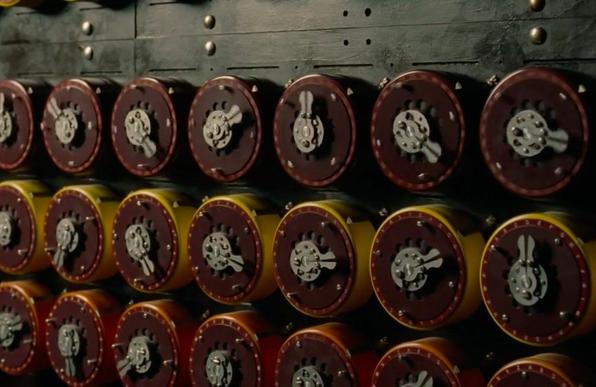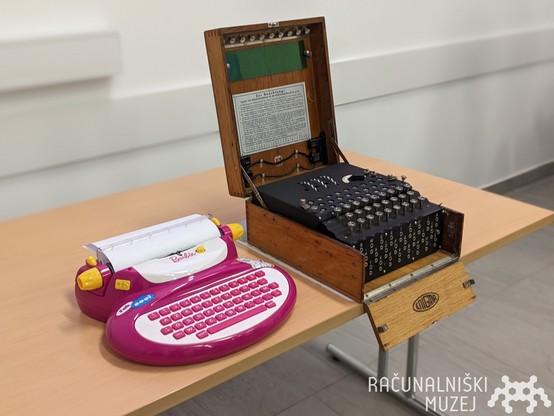🎭 Oh, #Kraken, the mighty fortress of #crypto, thwarting evil North Korean #hackers with the power of... job applications? 🚀 Next up, how they decrypted the Enigma machine using only LinkedIn requests! 🎩🔍
https://blog.kraken.com/news/how-we-identified-a-north-korean-hacker #NorthKorea #JobApplications #EnigmaMachine #HackerNews #ngated
#EnigmaMachine
Weekly output: Musk digitally deleting USAID, Arm vs. Qualcomm, U.K. vs. Apple, 8K TV, Bletchley Park
One of this week’s published stories began with reporting weeks ago; another began with notes and photos taken months ago.
2/3/2025: Musk’s Minions Deleting Digital Presence of US International Development Agency, PCMag
I could not just write about the weird digital erasure Elon Musk and his goons have been inflicting on the online presence of the U.S. Agency for International Development without reminding readers of three important bits of context: USAID does good and useful work (as vouched for in that quote from Georgetown University government-department chair Anthony Arend, four of whose classes I took as an undergrad 35-plus years ago); USAID constituted all of .4% of the federal budget in fiscal year 2024; Elon Musk’s tweets show no sign of him having any interest in the agency until January.
2/6/2025: Arm Drops Effort to Cancel Qualcomm’s Chip-Licensing Deal, PCMag
If you were considering buying a Windows laptop with one of Qualcomm’s power-efficient Snapdragon X processors, this should rank as very good news.
2/7/2025: Report: UK Orders Apple to Disable E2E Encryption on iCloud Backups Worldwide, PCMag
Writing up the Washington Post’s scoop about this dangerous demand by the U.K.’s Home Office gave me a crash course in looking up and citing legislation on Parliament’s Web site–without which I would have been writing about the Investigatory Powers Act without pointing people to the text of that 2016 statute and its 2024 amendments.
2/8/2025: In 2025, the Picture for 8K TVs (Still) Isn’t Looking Too Bright or Sharp, PCMag
I originally had delusions of writing this piece from CES with a Las Vegas dateline, but the weeks since then allowed me to get some additional numbers from the Consumer Technology Association and quiz another analyst as well as the head of the 8K Association.
2/9/2025: To See Codebreaking At Its Most Metal, Visit Bletchley Park, PCMag
Some of you may remember my writing a piece about Bletchley Park for the long-gone information-security publication The Parallax in 2018. I decided to revisit this museum of WWII codebreaking when my trip to London in October for Uber’s Go-Get Zero event (on Uber’s dime) left me with an afternoon free, and I’m glad I did because I was able to check out one exhibit that I’d had to skip earlier and see a few exhibits they’d added since then.
#8K #8KTV #AgencyForInternationalDevelopment #ArmHoldings #BletchleyPark #codebreaking #cryptography #EnigmaMachine #iCloudEncryption #InvestigatoryPowersAct #MuskCoup #Qualcomm #SnapdragonX #SnoopersCharter #UKHomeOffice #USAID
aaaaaaa-veeeeee mariiiiiiiiii-iiiii-aaaa
graaaa-tiaaaa pleeeee-naaaa
doooomi-nus teeeee CUM
#thedavincicode #enigmamachine #turingandthatsortofthing #spoo
#itsaboutcum
#OnThisDay, July 9, in 1941, British cryptologists led by Alan Turing broke the Enigma code used by the German army to direct ground-to-air operations on the Eastern front (depicted in The Imitation Game, 2014)
#Movies #Film #Cinema #Cinemastodon #Letterboxd #TodayInHistory #Histodons #Cryptography #Codebreaking #Enigma #EnigmaMachine #TheImitationGame
👨🏫 Dr. Mark Baldwin holds a talk on the Enigma machine in the museum 🗝️🏛️
#computermuseum #computerhistory #slovenia #ljubljana #softwareheritage #digitalheritage #nostalgia #nostalgie #nostalgi #enigmamachine #vintage #enigma #vintagecomputing #retro #europee #retrocomputing #cryptography #cipher #wwii #worldwarii #drenigma
An exhibition showcasing the original Enigma, which played a significant role in shaping the fate of World War II, and a lesser-known innocent children's typewriter, Barbie, manufactured in Slovenia. Along with a range of typesetting features, such as letter-spacing and underline, this children’s toy was capable of encoding and decoding secret messages, using a built-in cipher mode
#computermuseum #computerhistory #slovenia #ljubljana #barbie #vintage #retro #enigma #enigmamachine #cryptography
Code Breaking in the Pacific
You’ve heard about Enigma cipher machines, and how codebreakers at England’s Bletchley Park cracked messages during World War II. There are amazing stories about how the specialized machines they built helped them decipher messages, and become the predecessors of today’s computers.
But you may not have heard about a different kind of codebreaking going on in the Pacific during the same period. The problems and techniques were completely different, because enemy messages were transmitted in code, not cipher. And there were some incredible success stories from this period, such as the battle of Midway, which turned the tide of the conflict in the Pacific.
The methods used in code breaking behind those successes are quite different to those used against encryption machine ciphers such as the Enigma. The reason is that the main cipher systems used by the Japanese were based on code books rather than a machine. “Code Breaking in the Pacific” is the first book to provide a complete description of those systems and the development of the techniques used to break them. It addresses the last major gap in the literature of WW2 cryptography and most likely the last major gap in the literature of WW2.
This very dense book was written by two mathematicians: Peter Donovan and John Mack. Math and I have never been on good terms, we’re definitely not friends. So the math in the book is *completely* over my head. But there were some interesting nuggets that jumped out:
☑️ As early as 1916, the British were using Hollerith punch-card equipment from the U.S. to decode enemy messages. The Hollerith company eventually became IBM.
☑️ The skills required for successful decoding . . . [of these messages] are more akin to the linguistic challenge of determining the nature and meaning of an unknown written language than to those needed for elucidating the operation of a cipher machine . . .”
☑️ Lightly used code books were particularly difficult to crack.
☑️ The use of boilerplate messages by the other side provided codebreakers with a way to crack messages.
☑️ Some of these systems were designed to keep information secure only for a few hours.
☑️ Choosing to doubly encrypt messages often made the system *less* secure, not more secure.
☑️ Major pieces of disinformation were known as “purple whales.” 🐳🐋🐳
If you have an interest in math and history, this may be right up your alley.
But this book isn’t cheap. One option: “check it out like a library book” from a local university library.
#WW2
#CodeBreaking
#BookReview
#Cryptography
#Enigma
#EnigmaMachine
#BletchleyPark
#CodeBreakingInThePacific
#TelegraphicCodeBooks
Note: This is *not* an affiliate link. I’m simply recommending this high-quality book for those who might find it interesting.
An authentic #SecondWorldWar #Enigmamachine is now on display at the museum – along with information about the #University of #Waterloo’s special connection to decoding #Nazi messages
#OnThisDay, July 9, in 1941, British cryptologists led by Alan Turing broke the Enigma code used by the German army to direct ground-to-air operations on the Eastern front (depicted in The Imitation Game, 2014)
#Movies #Film #Cinema #Cinemastodon #Letterboxd #TodayInHistory #Histodons #Cryptography #Codebreaking #Enigma #EnigmaMachine #TheImitationGame
Code Breaking in the Pacific
You’ve heard about Enigma cipher machines, and how codebreakers at England’s Bletchley Park cracked messages during World War II. There are amazing stories about how the specialized machines they built helped them decipher messages, and become the predecessors of today’s computers.
But you may not have heard about a different kind of codebreaking going on in the Pacific during the same period. The problems and techniques were completely different, because enemy messages were transmitted in code, not cipher. And there were some incredible success stories from this period, such as the battle of Midway, which turned the tide of the conflict in the Pacific.
The methods used in code breaking behind those successes are quite different to those used against encryption machine ciphers such as the Enigma. The reason is that the main cipher systems used by the Japanese were based on code books rather than a machine. “Code Breaking in the Pacific” is the first book to provide a complete description of those systems and the development of the techniques used to break them. It addresses the last major gap in the literature of WW2 cryptography and most likely the last major gap in the literature of WW2.
This very dense book was written by two mathematicians: Peter Donovan and John Mack. Math and I have never been on good terms, we’re definitely not friends. So the math in the book is *completely* over my head. But there were some interesting nuggets that jumped out:
☑️ As early as 1916, the British were using Hollerith punch-card equipment from the U.S. to decode enemy messages. The Hollerith company eventually became IBM.
☑️ The skills required for successful decoding . . . [of these messages] are more akin to the linguistic challenge of determining the nature and meaning of an unknown written language than to those needed for elucidating the operation of a cipher machine . . .”
☑️ Lightly used code books were particularly difficult to crack.
☑️ The use of boilerplate messages by the other side provided codebreakers with a way to crack messages.
☑️ Some of these systems were designed to keep information secure only for a few hours.
☑️ Choosing to doubly encrypt messages often made the system *less* secure, not more secure.
☑️ Major pieces of disinformation were known as “purple whales.” 🐳🐋🐳
If you have an interest in math and history, this may be right up your alley.
But this book isn’t cheap. One option: “check it out like a library book” from a local university library.
#WW2
#CodeBreaking
#BookReview
#Cryptography
#Enigma
#EnigmaMachine
#BletchleyPark
#CodeBreakingInThePacific
#TelegraphicCodeBooks
Note: This is *not* an affiliate link. I’m simply recommending this high-quality book for those who might find it interesting.
Enigma.
Code Breaking in the Pacific
You’ve heard about Enigma cipher machines, and how codebreakers at England’s Bletchley Park cracked messages during World War II. There are amazing stories about how the specialized machines they built helped them decipher messages, and become the predecessors of today’s computers.
But you may not have heard about a different kind of codebreaking going on in the Pacific during the same period. The problems and techniques were completely different, because enemy messages were transmitted in code, not cipher. And there were some incredible success stories from this period, such as the battle of Midway, which turned the tide of the conflict in the Pacific.
The methods used in code breaking behind those successes are quite different to those used against encryption machine ciphers such as the Enigma. The reason is that the main cipher systems used by the Japanese were based on code books rather than a machine. “Code Breaking in the Pacific” is the first book to provide a complete description of those systems and the development of the techniques used to break them. It addresses the last major gap in the literature of WW2 cryptography and most likely the last major gap in the literature of WW2.
This very dense book was written by two mathematicians: Peter Donovan and John Mack. Math and I have never been on good terms, we’re definitely not friends. So the math in the book is *completely* over my head. But there were some interesting nuggets that jumped out:
☑️ As early as 1916, the British were using Hollerith punch-card equipment from the U.S. to decode enemy messages. The Hollerith company eventually became IBM.
☑️ The skills required for successful decoding . . . [of these messages] are more akin to the linguistic challenge of determining the nature and meaning of an unknown written language than to those needed for elucidating the operation of a cipher machine . . .”
☑️ Lightly used code books were particularly difficult to crack.
☑️ The use of boilerplate messages by the other side provided codebreakers with a way to crack messages.
☑️ Some of these systems were designed to keep information secure only for a few hours.
☑️ Choosing to doubly encrypt messages often made the system *less* secure, not more secure.
☑️ Major pieces of disinformation were known as “purple whales.” 🐳🐋🐳
If you have an interest in math and history, this may be right up your alley.
But this book isn’t cheap. One option: “check it out like a library book” from a local university library.
#WW2
#CodeBreaking
#BookReview
#Cryptography
#Enigma
#EnigmaMachine
#BletchleyPark
#CodeBreakingInThePacific
#TelegraphicCodeBooks
Note: This is *not* an affiliate link. I’m simply recommending this high-quality book for those who might find it interesting.
Code Breaking in the Pacific
You’ve heard about Enigma cipher machines, and how codebreakers at England’s Bletchley Park cracked messages during World War II. There are amazing stories about how the specialized machines they built helped them decipher messages, and become the predecessors of today’s computers.
But you may not have heard about a different kind of codebreaking going on in the Pacific during the same period. The problems and techniques were completely different, because enemy messages were transmitted in code, not cipher. And there were some incredible success stories from this period, such as the battle of Midway, which turned the tide of the conflict in the Pacific.
The methods used in code breaking behind those successes are quite different to those used against encryption machine ciphers such as the Enigma. The reason is that the main cipher systems used by the Japanese were based on code books rather than a machine. “Code Breaking in the Pacific” is the first book to provide a complete description of those systems and the development of the techniques used to break them. It addresses the last major gap in the literature of WW2 cryptography and most likely the last major gap in the literature of WW2.
This very dense book was written by two mathematicians: Peter Donovan and John Mack. Math and I have never been on good terms, we’re definitely not friends. So the math in the book is *completely* over my head. But there were some interesting nuggets that jumped out:
☑️ As early as 1916, the British were using Hollerith punch-card equipment from the U.S. to decode enemy messages. The Hollerith company eventually became IBM.
☑️ The skills required for successful decoding . . . [of these messages] are more akin to the linguistic challenge of determining the nature and meaning of an unknown written language than to those needed for elucidating the operation of a cipher machine . . .”
☑️ Lightly used code books were particularly difficult to crack.
☑️ The use of boilerplate messages by the other side provided codebreakers with a way to crack messages.
☑️ Some of these systems were designed to keep information secure only for a few hours.
☑️ Choosing to doubly encrypt messages often made the system *less* secure, not more secure.
☑️ Major pieces of disinformation were known as “purple whales.” 🐳🐋🐳
If you have an interest in math and history, this may be right up your alley.
But this book isn’t cheap. One option: “check it out like a library book” from a local university library.
#WW2
#CodeBreaking
#BookReview
#Cryptography
#Enigma
#EnigmaMachine
#BletchleyPark
#CodeBreakingInThePacific
#TelegraphicCodeBooks
Note: This is *not* an affiliate link. I’m simply recommending this high-quality book for those who might find it interesting.
It's amazing and it's BACK! The #CodeClub I run with a friend at our local primary school starts up again this afternoon! We're going to get them started with an introduction to the #EnigmaMachine https://bletchleypark.org.uk/our-story/enigma/
We'll be using this fantastic Scratch Enigma emulator today as well: https://tinyurl.com/enigmaCC
Incredible, must have been thrown over board sometime in the 1940's to avoid being captured. Thank goodness for Bletchley Park UK. #history #ww2 #alanturing #enigmamachine
Nice find.
"Divers scouring the Baltic Sea for discarded fishing nets have stumbled on the rarest of finds: an Enigma encryption machine used by the Nazis to encode secret messages during World War II."
#ComputerHistory #EnigmaMachine #WorldWar2 #Technology #Encryption



